Women in the Canadian Army
In 1941, the Army opened its doors to women with the creation of the Canadian Women's Army Corps (CWAC). The servicewomen primarily filled support jobs to allow men to perform combat duty. Before 1941 women were limited to the role of Nursing Sisters in the Army's Medical Corps. The CWAC was disbanded in September 30, 1946. Women were allowed to enlist in the Canadian Army beginning in the early 1950s.
Featured Jewish CWACs:
Esther Bubis (Thorley) / Eva Cossman (Berry) / Brenda Diamond (Fishauf) / Ruth Easser / Evelyn Fainer (Robson) / Cecilia Feingold (Guttman) / Mimi Freedman (Hart) / Eva Greenberg / Eve Keller (Daniels) / Frances Labensohn (Binder) / Daisy Lazare (Friedberg) / Goldie Margolis (Lehmann) / Lillian Meltzer (Schoen) / Evelyn Miller / Ruth Penner / Mildred Richmond /Miss Spiegel / Rose Weingarten (Fogel) / Edah Katherine Wodlinger (Melniker)
Featured Jewish Nursing Sisters in the RCA Medical Corps:
Bessie Fagin (Davy) / Rose Novick (Pellatt) / Freda Swedlove (Lithwick) / Estelle Ruth Tritt (Aspler)
EVELYN FAINER
Married Name: Evelyn Robson
Birthplace: Ottawa, December 17, 1914
Service Unit: Canadian Women's Army Corps (CWAC)
Rank: Private
Job: Cook
Enlistment Date: December 17, 1941
Discharge Date: January 27, 1945
Death Date: July 27, 1972
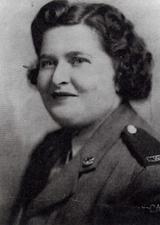
Photo courtesy of the Saint John Jewish Historical Society Inc.
Born in Ottawa, Evelyn was raised in Saint John, New Brunswick. She left school at age 14 and had worked as a clerk at a shoe store for seven years at the time of enlistment. While her employer promised to give her employment upon discharge from the service, Evelyn was not interested in returning to that type of work. It was through her work in the shoe store that she met her future husband Clarence Robson.
When Clarence was posted to England, Evelyn enlisted in the CWACs. Her enlistment form stated that she was "eager for overseas service." Servicemen were always flirting with the servicewomen, but being engaged to a soldier protected Evelyn from unwanted sexual advances. She was first posted as a cook at the Howe Lake Military Hospital not far from Saint John.
In 1943 she was assigned overseas, embarking to England on March 31, 1943, to work as a cook in Aldershot and London. After about eighteen months overseas, she returned to Canada. She was released from service for compassionate reasons as her step-mother was not well and her father needed assistance with his bakery. Her father had enlisted in the army in World War I, serving in the Canadian Overseas Expeditionary Force. Her brother Frank enlisted in the Royal Air Force in England in 1938, serving with the British until spring 1945, at which time he transferred to the RCAF and served until 1947.
After the war Evelyn continued to work in her father's bakery and, in 1946 married Clarence in Sudbury. The newlyweds settled in Sudbury, where they raised three children. Evelyn only worked outside the home seasonally, during the Christmas period, initially at a shoe store and then at the post office. An avid sewer, Evelyn was so dedicated to creating pajamas for the Red Cross that once when she broke her arm, she showed her husband how to sew so he could complete the project for her.
Sources:
Bessner, Ellin. 2018. “Jewish Women in Uniform.” In Double Threat: Canadian Jews, the Military and World War II. 103-112. Toronto: New Jewish Press.
Correspondence from Ellin Bessner.
Correspondence from Evelyn Fainer Robson's daughter.
"On-the-Job Hunches Pay off to the Tune of $1,000 and $300." 1959. Inco Triangle 20, no.9:12-13. (Includes information on Evelyn - her husband won the $1,000 )
Remembering Those Who Served in World War II. Saint John Jewish Historical Museum, Saint John. (Facebook page)
"Retired on Inco Pension with 20 or more years of service." 1971. Inco Triangle 31, no. 3: 19.
ESTHER BUBIS
Married Name: Esther Thorley
Service Unit: Canadian Women's Army Corps (CWAC)
Enlistment Date: June 1943
Rank: Private
Job: Office work
Death Date: February 13, 2018

Photo courtesy of Ellin Bessner
Esther grew up in Toronto, the baby amongst her seven other siblings. Her brother Meyer, who enlisted in the army at the very beginning of the war, was killed in the 1942 Dieppe raid. Esther felt very strongly that someone from her family should continue the flight against Hitler. After finishing Grade 10, she began employment as a seamstress and as a babysitter. As soon as she reached her 18th birthday, accompanied by her Mom, she marched into the recruiting office. Like her fellow servicewomen, Esther received a much lower rate of pay than that provided to servicemen. In Esther's case, seventy cents per day, while a just recently enlisted serviceman received $1.30 per day. Posted to Vancouver, Esther performed office work. As part of her duties included processing orders regarding personnel deployment, Esther was able to access personal information to determine if a serviceman was single or not before accepting a date.
Coming from a kosher home, Esther was proud of her religion and was very open about being Jewish. Her observance of Jewish customs did get her into trouble. When her father died she took a leave to return home to Toronto for the funeral and stayed for the shiva (first seven days of mourning). The Jewish chaplain in Vancouver had indicated this would not be a problem, but her military superiors considered her AWOL and confined her to barracks for a week.
After the war she returned to Toronto and married Harry Thorley, also a veteran. Esther noted how much she learned from her military service and that it made her a better person.
Sources:
Bessner, Ellin. 2018. Double Threat: Canadian Jews, the Military and World War II. Toronto: New Jewish Press.
Bessner, Ellin. "One of last remaining Canadian Jewish women WWII army veterans has died." Ellen Bessner blog, February 21, 2018. (Blog post includes a brief clip from interview an Ellin did with Esther)
BRENDA DIAMOND (DIAMENT)
Married Name: Brenda Fishauf
Birthplace: Staszow, Poland, 1914
Service Unit: Canadian Women's Army Corps (CWAC)
Death Date: September 27, 2015
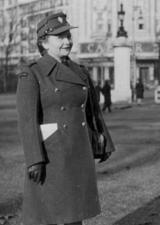
.
Photo courtesy of Ester Reiter
From the 1930s to the late 1940s the Canadian government had a very restrictive immigration policy regarding Jewish immigrants. Brenda (Breindl), born in Poland, was one of the few Jews admitted to Canada during this period. Mrs. B. Roseman of Kitchener, Ontario submitted a successful application in 1937 to have Brenda, then in her early twenties, come to Canada to assist with domestic work. While government records identify Mrs Roseman as an aunt, Brenda in her interview with Ester Reiter, notes that Mrs. Reitman was a friend of Brenda’s sister, with government connections. The Approved Order in Council for Brenda's admission to Canada ends with the comment that William Daum Euler (Federal Minister of Trade and Commerce from 1935-1940) was "interested in this case." In their application, the Roseman's had to indicate the value of the stock in their furniture store, the total monthly sales, the amount in their savings account, and the value of owned properties and mortgages and rental income for those properties. As well, they assured the government that they would make sure that Brenda was provided for.
Brenda, from her childhood was very keen on learning, and while in Poland was a member of Hashomer Hatzair, a Jewish socialist youth group. Brenda finished school at 14 and spent her time helping her mother at home (hers was a family of seven children plus an orphaned cousin) and working in the family store. Life was tough economically and politically for the Jews in Poland. Brenda describes it as living the "life of [an] orphan in everyday life." Brenda's only dress was a gift from the American Jewish Joint Distribution Committee, a Jewish Humanitarian organization. Brenda wrote to her sister who had immigrated to Canada in 1928 and asked for her help in getting to Canada. Her sister arranged for the Roseman family to sponsor Brenda as their maid. While her parent's disapproved of Brenda's boyfriend Dov, they agreed to their marriage in an unofficial religious ceremony just before her departure to Canada in 1937. The young couple hoped that they would shortly be together again. As her immigration papers had been processed as a single woman, she kept her marriage secret from government officials and her family in Canada. After the war broke out, Brenda became very concerned for Dov's life, and would have returned to Poland if transportation had been possible.
In 1939, Brenda was working for her brother-in-law and learning how to sew from her sister. By 1943, she was living in Toronto as a dressmaker. She became a naturalized Canadian on April 8, 1943. As soon as she received her Canadian citizenship, Brenda enlisted in the army. She hoped to go overseas and find Dov. When she applied at the enlistment centre, her English was so limited that she initially returned the application papers blank. After six months of basic training at Kitchener, she was assigned to work on costumes for the newly created army show. While Brenda did go overseas in 1943, her posting was to England with the army show. Once in England she approached various military officials for permission to go to Poland, but was unsuccessful in securing authorization to travel to the war zone. Despite this setback, Brenda had positive memories of her years in service.
When the war was over, she tried without success to locate Dov through the various Red Cross agencies and the Canadian Jewish Congress. Brenda lost Dov, most of her family, and many of her friends in the Holocaust.
Upon her return to Canada, Brenda worked at the National Ballet and the Stratford Theatre making performance costumes. Brenda continued with her socialist leanings and her love of learning. She joined a Yiddish reading circle and the Toronto Jewish Folk Choir. Brenda later married widowed Holocaust survivor Nathan Fischauf. A very feisty and independent woman, Brenda, in her 90's travelled on her own to Cuba for a two-month vacation. Apparently when she immigrated to Canada, the Polish officials could not find any records of her birth so they made her a twin of her sister who was two years older. So, although her obituary reports that she passed away at the age of 103, Brenda was in fact only 101 in 2015.
Artwork inspired by Brenda's story.
Sources:
Abella, Irving and Harold Troper. 2012. None Is Too Many: Canada and the Jews of Europe, 1933-1948. Toronto: University of Toronto Press.
Brenda Fishauf. Obituary. Toronto Star, September 29, 2015. (viewed on Legacy.com)
Canadian Naturalization Records 1915-1951. Library and Archives Canada. Ottawa
Canada, Immigrants Approved in Orders in Council, 1929-1960. (viewed on Ancestry.com)
Information from Ester Reiter.
Fishauf, Brenda. 2004. Interview with Ester Reiter. (unpublished transcript provided by Ester Reiter)
Reiter, Ester. 2016. A Future Without Hate or Need: The Promise of the Jewish Left in Canada. Toronto: Between the Lines.
Wolters-Fredlund, Benita. 2009. "Experiencing Beauty in the Music of the Holocaust." The Cresset 72, no. 4:21-31.
Wolters-Fredlund, Benita. 2006. "Report on Recent Research in Canadian Music: "We Shall Go Forward with our Songs into the Fight for Better Life": Identity and Musical Meaning in the History of the Toronto Jewish Folk Choir, 1925-1959." Institute for Canadian Music Newsletter 4, no. 1:8-10.
FRANCES LABENSOHN / BINDER
Married Name: Frances Binder
Birthplace: Montreal, Quebec, February 19, 1919
Service Unit: Canadian Women's Army Corps (CWAC)
Rank: Private
Job: Clerk
Enlistment Date: October 5, 1942
Discharge Date: August 28, 1944
Death Date: October 31, 1996
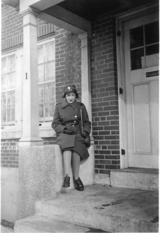
Photo courtesy of the Jewish Historical Society of Southern Alberta
Born in Montreal, Frances completed up to Grade 9, and then took one year of night school courses in shorthand, typing and bookkeeping. Her first employment was a ten-month part-time job as an inspector in a clothing factory, followed by clerical work for just over a year, and then five years of employment at the Jewish newspaper Canadian Jewish Review. At the paper, she worked as a secretary, and also did some bookkeeping and proofreading, earning $20 per week plus commissions. In October 1942, at the age of 25, she enlisted with a promise from George Cohen, her supervisor at the Canadian Jewish Review, that he would hold a position for her.
Her enlistment record indicated that while her typing "is ninety words per minute, shorthand is poor." It goes on to describe her as "a short, slight, Jewish girl with dark hair and eyes and shell-rimmed glasses. Appears quite active and aggressive, talkative and fairly stable." The report recommended that Frances be given general office duties, and Frances became a Clerk (general duty).
Frances was posted to Montreal, Kitchener, and St. John's. Although military personnel were expected to request permission from their superiors to marry, on December 4, 1943 Frances married Signalman Binder before a Rabbi and two witnesses in Kingston, Ontario, prior to seeking approval. On December 6, 1943 she applied for authorization to marry and on the same day the army granted consent. Her service records were then amended to reflect her married name. In August 1944, she was discharged, and later received the Canadian Volunteer Service Medal (CVSM) for completing eighteen months of voluntary service.
Prior to enlisting Frances was a participant in Communist organizations and she continued her involvement in social causes when she returned from service. Separated in the late 1950s, she lived at various times in both Toronto and Montreal, and returned to work as a secretary and bookkeeper to support herself and her two daughters. For the last few years of her life she resided in Calgary where her eldest daughter and family were living. Her daughter notes, that while her mother spoke very little about her wartime experience, "World War II military service seems to have been a formative point in her early life that offered many benefits in her last years."
Sources:
Service files. (copy provided by her daughter, Susan Podlog)
Correspondence from her daughter, Susan Podlog.
ROSE WEINGARTEN
Married Name: Rose Fogel
Service Unit: Canadian Women's Army Corps (CWAC)
Rank: Private
Death Date: August 29, 2016

Last Post Fund National Field of Honour (Image courtesy of the Jewish Genealogical Society of Montreal JGS-Montreal.org)
Rose is an example of a servicewoman for whom the little information that has been found was gleaned from the social pages of the Canadian Jewish Review and from her headstone. The November 23, 1945, Canadian Jewish Review on page seven includes a notice from Rose's parents Mr and Mrs H. Weingarten that the engagement of their daughter, a member of the CWAC, to Gunner Harry Fogel took place in Apeldoorn, Holland. Rose, like a number of other servicewomen, met her husband while in service and became engaged and married while still in the military. She was one of a minority of servicewomen who served overseas.
Rose is survived by her two daughters and family. In retirement she volunteered for a number of organizations, including the Entraide Benevole Metro Montreal and the Canadian Legion.
Sources:
"Rose Weingarten Fogel." Last Post National Field of Honour. List of Burials. Jewish Genealogical Society of Montreal, Montreal. (website)
List of Obituaries. Gary Pearlman's Homepage. (website)
"Approaching Marriages." Canadian Jewish Review, November 23, 1945, 7
EDAH KATHERINE WODLINGER
Married Name: Edah Katherine Melniker
Birthplace: Veregin, Saskatchewan, July 6, 1922
Service Unit: Canadian Women's Army Corps (CWAC)
Death Date: September 16, 1997

.
Photo courtesy of Karen Dyck
While most of the Jewish women who enlisted were born in Canada, most of their parents were immigrants from Europe. Edah is one of the few second-generation Canadians that enlisted. Her father, Harry Abraham Wodlinger, was born in Winnipeg in 1891.
Initially, the only information on Edah's service came from a listing in the Canadian Jewish War Memorial Book of Remembrance. Further searching on the web located a copy of remarks made by her niece at Edah's funeral. This tribute confirmed Edah's service as a CWAC and shared an interesting story about how during her military service Edah decided to attend an event to cheer up the troops, only she had the incorrect day and arrived at a stag party of 500 men. She was encouraged to join the party and had a great evening. Both her brothers Leonard and Donald served with the Canadian Army. Donald was posted overseas with the Royal Canadian Artillery.
In 1945, Edah moved to the United States and became a naturalized American in 1954. In 1946, Edah married Bernard Melniker who had served in the United States Army. After her marriage ended, she raised her son as a single parent, working in accounting and office management to support her family. Edah's son, a Sergeant 1st class, served in the United States military for twenty years.
Sources:
Adler, Oscar Adler and the Canadian Jewish War Memorial Association. 2004. Canadian Jewish War Memorial Book of Remembrance. Toronto: Canadian Jewish War Memorial Association.
Ancestry.com
Edah Katherine Melnicker. geni.com
"Toronto News: Commode Boxes Come Home." Canadian Jewish Chronicle, January 31, 1941, 8.
Estelle Ruth Tritt
Married Name: Estelle Ruth Aspler
Birthplace: Montreal, April 26, 1919
Service Unit: Canadian Army Medical Corps
Rank: Lieutenant Nursing Sister
Enlistment Date: 1942
Death Date: April 14, 2007

Photo courtesy of Cynthia Toman
Estelle graduated as a nurse in 1941, worked briefly at the Jewish General in Montreal, and then signed up for the army. Shortly after she volunteered for service, her brother, serving in the airforce, was killed and Estelle was given the option to be released. She answered with, "No thanks. When do I go over?"
In 1943 Estelle was sent overseas to Britain with the Royal Canadian Army Medical Corps. They travelled on the Queen Elizabeth with twelve servicewomen squeezed into one small room. "No two people could stand at one time." She first worked at a hospital in Camp Bramshott and then was sent to No. 8 Canadian General Hospital in Farnborough. For about six weeks before D-Day, she was placed in isolation, as the No. 8 Canadian General was selected to treat only those who knew about D-Day. A few weeks after D-Day, the matron announced a need for three nurses to go to France. Estelle volunteered. On July 14, 1944, she arrived in France, where she worked in hospital tents set up on the roadside. She also treated German POWs. She used her little knowledge of Yiddish to ask basic questions of the POW patients. Estelle also treated self-inflicted wounds on soldiers desperate to escape the front line. Estelle noted that "people didn't understand that after Dieppe and Italy, Canada sent kids and there was no way they were well trained." From France she went to Belgium and was then posted to Holland.
In Holland she started searching, wherever she could, for the few Jews who had survived. She discovered a few that had been hidden or fought in the underground. She encountered women who had children taken from them, and children who wondered what happened to their parents. She attended a small Passover seder, the first seder in a long time for the few survivors. It was a very emotional evening and firmed Estelle's resolve to be a more observant Jew. People from Canada contacted her for help in locating surviving European family members, and she did what she could to reunite family members. She commented "The day the war ended, there wasn't a big celebration. There was only one feeling. Relief. We just sat around and said 'Thank God.' "
Art work inspired by Estelle's story.
Sources:
Bessner, Ellin. 2018. Double Threat: Canadian Jews, the Military and World War II. Toronto: New Jewish Press.
Estelle Aspler In The Memory Project. Veterans' Stories. Historica Canada (website)
Mickleburgh, Rod and Rudyard Griffiths. 2005. "Estelle Tritt-Aspler." In Rare Courage: Veterans of the Second World War Remember. 172-179. Toronto: McClelland & Stewart.
Obituary Montreal Gazette, April 16, 2007.
Toman, Cynthia. 2008. An Officer and a Lady : Canadian Military Nursing and the Second World War. Vancouver: UBC Press.
EVA COSSMAN
Married Name: Eva Berry
Birthplace: North Sydney, Nova Scotia, December 16, 1910
Service Unit: Canadian Women's Army Corps (CWAC)
Rank: Captain
Job: Secretary
Enlistment Date: 1942
Death Date: December 10, 2005
Although born in Nova Scotia, Eva was raised in Montreal and was a student at McGill University. She enlisted sometime in 1942 and in 1943 was one of the CWACs in attendance at a tea hosted by Princess Alice (mother of Prince Philip) for the CWAC. Eva worked with the Committee for the Protection of Prisoners of War in Enemy Hands. She served as secretary of the Prisoner of War Welfare Committee. In 1944, she was involved in selecting gifts for the Christmas parcels sent to Canadian prisoners of war captured by the Germans. Her obituary indicates she was also involved in the relocation of war brides to Canada.
In 1946 Eva returned home after one and half years of service overseas. After the war, Eva married and had three children. Once her children were in school, she worked in broadcasting with the Canadian Broadcasting Corporation. Eva also served on the Ottawa Board of Education, as well as many other organizations including the Unemployment Insurance Board of Referees.
Sources:
"Prisoners of War Receive Parcels from Services." Calgary Herald, August 24, 1944, 5.
"Social Notes - Montreal." Canadian Jewish Review, August 6, 1943, 3.
Obituary. Ottawa Citizen, December 12, 2005.
MIMI FREEDMAN
Married Name: Mimi (Miriam) Hart
Birthplace: Montreal, March 2, 1911
Service Unit: Canadian Women’s Army Corps (CWAC)
Rank: Staff Sergeant
Job: Driver, Administration, Interpreter
Enlistment Date: 1943
Death Date: April 23, 1994
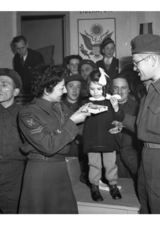
Born in Montreal, Mimi immigrated with her family to Belgium and then to England. The only Jewish Canadian World War II servicewoman to be decorated, Mimi first joined the London Ambulance Service in 1939, working with them until 1941, when according to her family, finding herself pregnant, Mimi returned to Canada and gave the baby up for adoption.
In 1943 Mimi was back in England where she enlisted in the CWACs. She did her army training in London, first working as a driver and then in administration assisting with the movement of troops. Shortly after D-Day she was in Normandy working with casualty reports and living in tents from which she could hear the constant gunfire. From France, Mimi was sent to Belgium (where she experienced V-2 rocket attacks in Antwerp), and then to Germany. In Germany, she was put in charge of the leave section for a unit of 1700 soldiers, and, due to her knowledge of German (she also could speak Flemish, Dutch and French), she was called up to work as a translator for witnesses in trials for soldiers. On October 1, 1945, Mimi was mentioned in despatches for her operational achievements.
She returned to Canada in April of 1946 and was discharged a month later. She married her cousin Bill Hart who had also served in the military. According to her family she was quite an aggressive driver, likely as a result of her wartime experience driving ambulances and other vehicles. Both her brother and her father served with the British military; her father was with the Royal Army Pay Corps, and her brother Sam was a Flight Lieutenant in the Royal Air Force.
Sources:
Ancestry.com
Bessner, Ellin. 2018. Double Threat: Canadian Jews, the Military and World War II. Toronto: New Jewish Press.
Farber, Bernie. Canada 145/150 – Mimi Freedman: Sgt. Mimi Freedman's Journey with the Canadian Women's Army Corps. Canadian Race Relations Foundation. (website, article originally published in the Canadian Jewish News, November 11, 2017)
“Mimi Freedman, Woman Veteran Oversees Six and a Half Years." Montreal Gazette, September 20, 1946.
Profiles of Courage – Mimi Freedman. Veterans Affairs. (website)
Rome, David. 1947. Canadian Jews in World War II Part I: Decorations. Montreal: Canadian Jewish Congress.
EVA GREENBERG
Birthplace: Winnipeg, Manitoba
Service Unit: Canadian Women’s Army Corps (CWAC)
Rank: Lieutenant
Job: Anti-Aircraft Artillery Training
Eva supervised twenty-two Kine-CWACs at the anti-aircraft artillery training centre in Halifax. These CWACs operated Kine-Theodolites, specialized equipment to test the performance of shells fired from anti-aircraft guns, helping to improve the performance of anti-aircraft gunners. These “artillery girls” also worked at the alert system control centre at Citadel Hill in Halifax. They experienced a German submarine very close to the Halifax harbour, as well as one in the Bay of Fundy.
Sources:
Conrod, Hugh W. 1983. Athene Goddess of War: The Canadian Women’s Army Corps, Their Story. Dartmouth, Nova Scotia: Writing and Editorial Services.
Girls Work Kine-Theodolite. AP Archive. (website)
DAISY LAZARE
(born Sarah "Daisy" Lazarovitz)
Married Name: Daisy Friedberg
Birthplace: Quebec
Service Unit: Canadian Women's Army Corps (CWAC)
Rank: Corporal
Job: Military Police
Enlistment Date: 1942
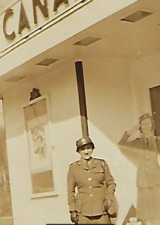
.
Photo courtesy of Ellin Bessner
The CWAC women military police unit was created in August 1942. Daisy was among the seventy-two CWACs chosen for the role. Training included judo, revolver shooting, instruction in military patrols, military law, and camouflage drills. While Daisy was featured in the Ottawa Journal for her work as a military police officer, her contributions were publicly downplayed with the story relegated to the "social news."
Sources:
Bessner, Ellin. 2018. “Jewish Women in Uniform.” In Double Threat: Canadian Jews, the Military and World War II. 103-112. Toronto: New Jewish Press.
Conrod, Hugh W. 1983. Athene Goddess of War: The Canadian Women’s Army Corps, Their Story. Dartmouth, Nova Scotia: Writing and Editorial Services. (See pages 88-90)
"Ottawa Girl in Military Police Learns Use of Pistol and Jujitsu." Ottawa Journal, December 1, 1942, 7.
EVE KELLER
Married Name: Eve Daniels
Birthplace: Regina, Saskatchewan, December 30, 1918
Service Unit: Canadian Women's Army Corps (CWAC)
Rank: Corporal
Job: Clerical Worker
Enlistment Date: November 25, 1943
Death Date: November 27, 2015
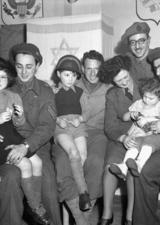
Eve at Chanukah party, Tilburg Netherlands, December 17, 1944
Image courtesy of Library and Archives Canada
The 1930s were economically challenging for Eve's family. When pressured to quit school and get a job, Eve told her parents that she was determined to finish Grade 10 and would run away if not allowed to do so. When Eve was about 16, her family moved from Canada to her maternal grandparents' home in London, England. There, Eve worked as a conductress on the London buses. There was one occasion during an air raid, when Eve had to decide whether to shelter at a transit barn or complete the run. Eve instructed the driver to return directly to the main terminal with the lights out, a wise decision as the barn was destroyed in the German attack.
Eve enlisted in England on November 25, 1943. Initially, she was turned away from the CWAC as her civilian job was considered an essential service. She was most upset, but a recruiting officer she met on her way out made sure that her enlistment application was accepted. Eve served near the front lines, typing and filing medical records for the troops. This responsibility put Eve directly under enemy fire. When the shelling got close, she would quickly gather her work and drive to a safer area. Her daughter Leslie Kinrys, in an interview with Ellin Bessner, recalled that on one occasion, Eve had left her office with the windows open and found a bullet lodged in the back of her chair upon her return.
Being in Europe allowed servicewomen like Eve to help the surviving European Jewish community. In December 1944, the Department of National Defence photographed Eve along with a Corporal from the United States Army and two other Jewish members of the Canadian Forces as they celebrated Chanukkah with Jewish children in Tilburg Netherlands. Eve's experience on the Continent also included visiting the Bergen Belsen concentration camp and attending a religious celebration which included a captured German soldier. The soldier was amazed that Jews still existed because Hitler had proclaimed otherwise. Eve and the other participants informed him that Hitler was wrong and that "Jews were still here."
Eve left military service in the summer of 1945, returning to Toronto where her family was now living. She was employed by Veterans Affairs doing clerical work. In 1949 she married and continued to work at Veterans affairs until her first child was born in 1956. While her boss was willing to hold her position, childcare services did not exist. Eve focussed her energy on looking after her family.
Sources:
Bessner, Ellin. 2018. “Jewish Women in Uniform.” In Double Threat: Canadian Jews, the Military and World War II. 103-112. Toronto: New Jewish Press.
Correspondence with Eve Keller's daughter, Leslie Kinrys
Kinrys, Leslie. 2014. “Remembering Women Vets,” The Canadian Jewish News, November 20, 2014.
Lillian Meltzer
Married Name: Lilian Schoen
Birthplace: Saint John, New Brunswick, September 21, 1907
Service Unit: Canadian Women's Army Corps (CWAC)
Rank: Private
Job: Secretary
Enlistment Date: 1942
Discharge Date: 1946
Death Date: August 27, 1994
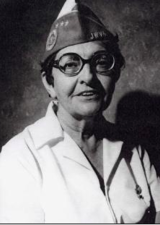
Photo courtesy of the Saint John Jewish Historical Society Inc.
At age 35, Lillian took a leave from her job at Metropolitan Life Insurance in New York to serve in the CWAC from 1942-1946. She served in England as the secretary to Chaplain Samuel Cass.
To commemorate the memory of Jewish Canadians who sacrificed their lives during the war, Jewish Canadians fighting in Europe donated funds to purchase 1400 trees for a Canada Memorial Grove in the Holy Land. A number of Ontario newspapers, including The Ottawa Journal for September 15, 1945, printed a picture of Lillian presenting a certificate for the memorial grove of trees to the Honourable John Percival Montague, Chief of Staff at Canadian Military Headquarters in London. Three of her brothers also served; Edward was in the United States Army, Gar was a member of the Royal Canadian Air Force, and William was conscripted as a National Resources Mobilization Act soldier.
In 1946 Lillian demobilized and resumed her work with Metropolitan Life Insurance, completing a forty year career with Metropolitan Life as a supervisor in the Florida office. In 1948 she married Sidney Schoen. She was extensively involved in volunteer work in her community including her local Cancer Research Center, synagogue, Hadassah, Jewish War Veterans Auxiliary, and the Jewish Community Center of Fort Lauderdale.
Sources:
“Memorial to Jewish Canadians." Ottawa Journal, September 15, 1945, 3 (also printed in Colborne Express September 27, 1945)
Obituary for Lillian Schoen (Meltzer). Saint John Jewish Historical Museum Synagogue Records, Saint John.
“Our Jewish Veterans: Remembering Those Who Served.” Zikaron: Saint John Jewish Historical Museum 31, no. 2: 7.
GOLDIE MARGOLIS
Married Name: Goldie Lehmann
Birthplace: Vermillion, Alberta
Service Unit: Canadian Women's Army Corps (CWAC)
Death Date: July 24, 2012
Goldie grew up in Canwood Saskatchewan, graduating high school at the age of 15. At 17, she volunteered for service, declaring she was 18 and thus eligible to enlist.
Goldie was part of the first contingent of CWACs sent to Italy in June 1944. The arrival of the CWACs meant that the men they were replacing could be deployed to the front lines. The servicewomen were informed that they would be working very close to the front lines of the Mediterranean theatre. Her brother Sam also served during World War II.
After her years of service Goldie studied at McGill, receiving her BA. In 1949 she married Maurice (Mossy) Lehman and settled in Winnipeg where she raised three children.
Sources:
Boss, Bill. 1944. “Ottawa Man Assigns Duties to First C.W.A.C.’s in Italy.” The Ottawa Journal, June 23, 1944, 2
Conrod, Hugh W. 1983. Athene Goddess of War: The Canadian Women’s Army Corps, Their Story. Dartmouth, Nova Scotia: Writing and Editorial Service. (see page 182)
Goldie Katherine Lehman (Margolis). Passages. Winnipeg Free Press. (website)
EVELYN MILLER
Birthplace: Alliance, Alberta, June 2, 1920
Service Unit: Canadian Women's Army Corps (CWAC)
Job: Secretary
Enlistment Date: October 4, 1942
Death Date: November 1, 2011
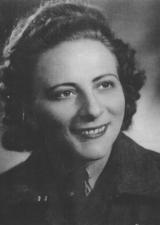
Photo courtesy of the Jewish Archives and Historical Society of Edmonton and Northern Alberta (JAHSENA) (jhse-69-is-jhse-713)
Evelyn, a business school graduate, was posted overseas as a secretary, working both in England and Belgium. She served for a total of three and half years. During her service her rank fluctuated. She initially advanced in rank from Private to Corporal to Sergeant, but then went back to Private after which she advanced to Lance Corporal, returned to Private and then again was promoted to Lance Corporal finally ending her service in 1946 as a Private. Her brother Stan also served.
After the war she attended the University of Alberta where she obtained a Commerce degree. She then moved to the United States for a career as an accountant only returning to Canada on retirement. During retirement, she volunteered with many organizations in Vancouver including the Legion and Jewish War Veterans.
Sources:
Allman, Ethel. 2001. Oral History. Jewish Historical Society of Southern Alberta, Calgary.
Evelyn Miller's pay book. Military Museums Library and Archives, Calgary.
Obituary. Edmonton Journal, November 3, 2011.
Wegner, Monica. 2012. “Dancing Backwards in Heels: Women’s Alumni Network.” Business Alumni Magazine, Fall 2011/Winter 2012, 7.
RUTH EASSER
Birthplace: Toronto, March 23, 1922
Service Unit: Canadian Women's Army Corps (CWAC)
Rank: Lieutenant
Job: Doctor
Death Date: 1975
Ruth received her medical degree in 1945, one of the few Jewish women to graduate from the University of Toronto Medical School. To assist in the war effort many of the medical school students served in the military. The university accelerated their medical training and the army enlisted the students, but did not require any army service until after internships. After internship, they attended officers’ training school.
Shortly after completion of her officer’s training, Ruth left the military. It was late 1946, and the services of the doctors were no longer urgently needed. Her brother Percy served from 1940-44. Ruth specialized in psychoanalysis, going on to make considerable contributions to the field of psychoanalysis as a teacher and researcher.
Sources of Further Information:
O’Neil, Mary Kay. 2004. The Unsung Psychoanalyst: The Quiet Influence of Ruth Easser. Toronto: University of Toronto Press.
O’Neil, Mary Kay and P. M. Lerner. 1998. “Ruth Easser M.D.” Psychoanalytic Review 85, no. 1: 117-138.
RUTH PENNER
Birthplace: Winnipeg, Manitoba, 1924
Service Unit: Canadian Women's Army Corps (CWAC)
Enlistment Date: 1942
Ruth’s father, Jacob Penner, a Ukrainian Mennonite, emigrated to Canada in 1904 and served for many years as a leader of the Communist Party of Canada. Her mother Rose was a Jewish immigrant also involved in radical causes. For his political leanings, Ruth’s father was interned from June 1940 to July 1942.
Despite the government’s treatment of their father, Ruth and her brother Norman both joined the Army, Norman in 1941 and Ruth in 1942. Her brothers Walter and Roland tried to enter the RCAF but were told “we don’t allow communists in the air force.” Both then applied to the Army. Walter was rejected due to a medical condition but Roland was enlisted in 1943. Norman was informed that as a communist he could not be promoted beyond the rank of corporal.
Because of her father's affiliation with the Communist party, as well as her former husband's (Harry Gulkin) links to the Communist party, Ruth had to deal with government surveillance throughout her childhood and into her adult years. In 1954 her Montreal home was raided by the Montreal Police force in search of communist material, and in the 1970s she had to make special travel arrangements to avoid any stopovers in the United States.
Ruth completed a Bachelor of Social Work at McGill University in 1950. She worked as a social worker for a few years and then remained at home to raise her two children, returning to social work in 1966. She was employed at the Lethbridge Rehabilitation Centre in Montreal until her retirement in 1989.
Sources:
Lewey, Laurel. 2010. "Anti-Communism in the Cold War and Its Impact on Six Canadian Social Workers." Canadian Social Work 12, no. 2: 10-24.
Penner, Roland. 2007. A Glowing Dream: A Memoir. Winnipeg: J. Gordon Shillingford.
MILDRED RICHMOND
Service Unit: Canadian Army Medical Corps - CWAC
Job: Medical Secretary
Information on Mildred is sparse. She graduated from Napanee, Ontario High School in 1939. In 1941 she was working as a stenographer. Mildred, the only women featured in the video No Greater Honour indicated that she was the first Jewish Canadian woman to join the military and the first to volunteer for overseas service. She served in London as a medical secretary for the army.
Sources:
Jewish War Veterans of Canada. 1987. No Greater Honour: A Record of Canadian Jewish Military Service. (Video, copies are available at the Ontario Jewish Archives and other local Jewish historical archives)
FREDA SWEDLOVE
Married Name: Freda Lithwick
Birthplace: Stouffville, Ontario, July 28, 1919
Service Unit: Canadian Army Medical Corps
Rank: Lieutenant Nursing Sister
Job: Nurse
Enlistment Date: March 1944
Death Date: March 4, 2013
Photo courtesy of the Ottawa Jewish Archive, OJA 1-655
Freda attend nursing school at Beth Israel Hospital in Boston from 1939-1942. She went on to specialize in Public Health Nursing at the University of Toronto. Her first working experience was in 1943 in Kingston with the Victorian Order of Nurses. Kingston was a hub of military activity and in March 1944 Freda enlisted in the army.
Freda wanted to be posted overseas but due to her mother’s concerns she stayed in Canada. Freda was posted to the Ottawa Rideau Military Hospital where she worked in the operating room caring for returning soldiers and soldiers posted in the area. In a reminiscence of her military experience, she noted that the most unusual surgeries conducted at the military hospital were circumcisions. The nurses were tasked with prepping the surgery suite but were not permitted to attend the procedure.
She was discharged on June 4, 1945 and married Hyman Lithwick two days later. Freda raised three children, was an active volunteer in many Ottawa Jewish organizations, and served as president of The Ottawa Hospital's Civic Campus Auxiliary.
Sources:
Freda Lithwick fonds, Ottawa Jewish Archives, Ottawa.
MacDonald, Mildred. 1999-2000. Interviews with Jewish Canadian veterans (audio). Canadian War Museum, Ottawa. (Includes interview with Freda Swedlove who initiated this project, see record from War Museum catalogue)
Lithwick Freda headstone. Jewish Memorial Gardens. (photograph)
Torontow, Cy, Jewish War Veterans of Canada, Ottawa Post and Ottawa Jewish Historical Society. 1999. There I was… A Collection of Reminiscences by Members of the Ottawa Jewish Community Who Served in World War II. Ottawa: Jewish War Veterans of Canada, Ottawa Post.
Rose Novick
Married Name: Rose Pellatt
Birthplace: Montreal August 18, 1918
Service Unit: Royal Canadian Army Medical Corps
Rank: Lieutenant Nursing Sister
Job: Nurse
Death Date: March 29, 1972
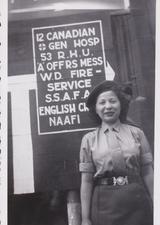
.
Photo courtesy of Morton Pellatt
Born and raised in Montreal, Rose was forced to take her nurse's training in the United States as antisemitism made it almost impossible for Jewish women to get into Canadian nursing schools. After completing her training, she returned to Canada. Rose worked at the Jewish General Hospital until joining the army as a nursing sister.
In 1944, she was posted overseas. In England, she was able to meet up with her brother Flying Officer William Novick of the RCAF (awarded the Distinguished Flying Cross in December 1944). From England, Rose was sent to Europe (France and Holland) following the invasion of Normandy. She worked alongside fellow Jewish-Canadian nurses Bessie Fagin and Estelle Aspler in tent hospitals set up behind the front lines. Victory over Japan Day (August 15, 1945), saw Rose still on duty in Europe and, in a letter to her future husband, Rose remarked, "It's V-J day and the patients haven't sobered up yet. I'm on duty now and the ward is especially rowdy. Every hour or so one of the patients goes "over the fence" and comes back with a bottle of Cognac - then things really get lively. They're a cute bunch though, and I really don't blame them for celebrating." In August 1945 Rose got word from the chaplain that there would be a Rosh Hashanah service in Amsterdam. Rose requested a leave to attend the service. While she was kept very busy with her nursing duties, Rose did take advantage of her leaves to visit sites in Europe. Growing up in the slums of Montreal, Rose relished this one-time opportunity to explore historical and cultural attractions. In her brief two night stay in Paris, Rose "just tore around like mad every moment of the precious time."
A doctor she worked with overseas was so impressed with her proficiency in managing wounds that he hired her to be part of the nursing staff at the Queen Mary Veterans Hospital in Montreal after the war.
Rose married and had two children. Once her children were in high school, Rose returned to nursing. She passed away at a relatively young age in her early fifties.
Art work inspired by Rose's story
Sources
Information from Rose Novick's family.
Rome, David. 1947. Canadian Jews in World War II Part I: Decorations. Montreal: Canadian Jewish Congress, 40.
Cecilia Feingold
Married Name: Cecilia Guttman
Birthplace: Jastreb, Czechoslovakia, April 13, 1922
Service Unit: Canadian Women's Army Corps (CWAC)
Rank: Sergeant
Job: Secretary
Death Date: December 29, 2016

.
Photo courtesy of Stan Guttman
Nine-year-old Cecilia Feingold immigrated with her parents and siblings to Canada from Jastreb, Czechoslovakia. Her family settled in Yorkton, Saskatchewan.
Cecilia joined the Canadian Army and served for four years as a secretary in the intelligence area in Ottawa and in Washington, DC. In 1941 the first few CWACS were assigned to the Canadian Legation office in Washington. By mid-1943, over 100 CWACS, including Cecilia, were working in the United States. Although, Cecilia never talked to her family about her military experience, perhaps because she was involved in highly classified work, in a conversation with one of her children she did disclose that she worked in intelligence translating Japanese to English. As W. Hugh Conrod noted in his 1983 history of the CWAC, “the confidentiality and secrecy of their work in those war offices made a lasting impression on the CWACS—most of them are still reluctant to discuss it.” Possibly, Cecilia was one of the CWACS selected to work in spymaster Sir William Stephenson’s Washington office. Like many of her fellow servicewomen, her obituary makes no mention of her military service.
After the war, Cecilia moved to Calgary for work. In Calgary, Cecilia met and married fellow army veteran Sidney Guttman. Cecilia spent the rest of her life in Calgary raising three children and running the iconic Calgary children’s wear store Lad and Lassie with her husband.
Art work inspired by Cecilia's story
Sources
Conrod, W. Hugh. 1983. Athene, Goddess of War: The Canadian Women’s Army Corps: Their Story. Dartmouth, N.S.: Writing and Editorial Services. (see especially pages 157-160)
Information from Cecilia Feingold’s family
Obituary. Calgary Herald. December 30, 2016.
Bessie Fagin
Married Name: Bessie Davy
Service Unit: Royal Canadian Army Medical Corps
Rank: Lieutenant Nursing Sister
Job: Nurse
Death Date: May 23, 1990
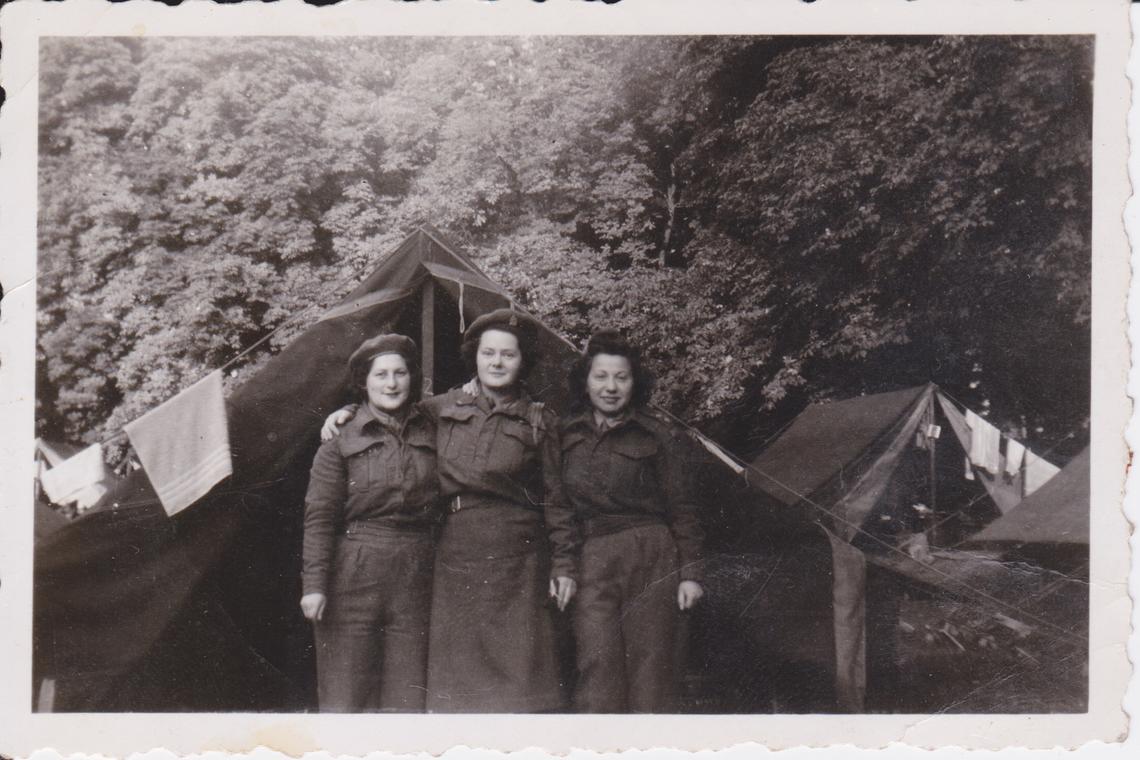
Photo courtesy of Morton Pellatt (Bessie is on the left side)
Bessie is another example of a veteran whose information was gleaned from small snippets in various sources. A photograph provided by Nursing Sister Estelle Tritt shows Bessie, Rose Novick and Estelle, standing in front of a hospital tent in Holland in 1945. This confirms her work overseas as a nursing sister. Estelle notes on the back of the photograph that Bessie married a Rabbi in England and brought a “war husband” back to Canada. While almost 50,000 “war brides” came to Canada due to overseas marriages with Canadian servicemen, this is likely one of the few instances of a “war husband.” A 1945 engagement notice in the Ottawa Journal further confirms Bessie‘s role in the military and notes that her husband, Gabriel Davy (Dawidowiez), had a Ph.D.
Both Bessie and her husband, Rabbi Dr. Davy, are buried in the United Jewish Community Cemetery in Ottawa.
Art work inspired by Bessie's story
Sources
Ancestry.com
Index of the United Jewish Community Cemetery, Ottawa, Ontario
Photograph of Estelle Tritt, Bessie Fagin and Rose Novick donated by Estelle Tritt to the Canadian Jewish Military Museum. (Copy also received from Morton Pellatt)
Miss Spiegel
Service Unit: Canadian Women's Army Corps (CWAC)
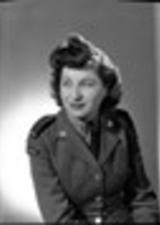
.
Photo courtesy Ontario Jewish Archives
Miss Spiegel is an example of a servicewomen for whom we do not even have a first initial. Her service in the Canadian Women's Army Corps is identified only through a portrait photograph held by the Ontario Jewish Archives and a last name only listing in the Canadian Jewish War Memorial Book of Remembrance provides further evidence that she served. This portrait taken in March 1944, is part of a series of Jewish military portraits created in the 40s by Toronto portrait photographer Sylvia Schwartz . Sylvia Schwartz also took a photograph of a Victor Spiegel serving in the RCAF, indicating a possible connection between Victor and Miss Spiegel.
Artwork inspired by Miss Spiegel's story.
